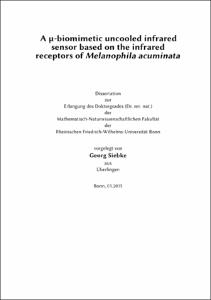Siebke, Georg: A μ-biomimetic uncooled infrared psensor based on the infrared receptors of Melanophila acuminata. - Bonn, 2016. - Dissertation, Rheinische Friedrich-Wilhelms-Universität Bonn.
Online-Ausgabe in bonndoc: https://nbn-resolving.org/urn:nbn:de:hbz:5n-42040
Online-Ausgabe in bonndoc: https://nbn-resolving.org/urn:nbn:de:hbz:5n-42040
@phdthesis{handle:20.500.11811/6571,
urn: https://nbn-resolving.org/urn:nbn:de:hbz:5n-42040,
author = {{Georg Siebke}},
title = {A μ-biomimetic uncooled infrared psensor based on the infrared receptors of Melanophila acuminata},
school = {Rheinische Friedrich-Wilhelms-Universität Bonn},
year = 2016,
month = jan,
note = {The pyrophilous beetle Melanophila acuminata possesses an organ sensitive to IR radiation. It employs a photomechanic detection principle: A liquid filled pressure chamber is heated by absorbing the radiation. The liquid expands and leads to the deflection of a mechanosensitive dendrite. In addition, a sophisticated compensation mechanism prevents the build-up of large pressures.
In this work, a biomimetic IR sensor based on the IR receptors of Melanophila acuminata is developed by means of micro systems technology. The sensor consists of two liquid-filled chambers that are connected by a micro-fluidic system. Absorption of IR radiation by one of the chambers leads to the heating and expansion of a liquid. The increasing pressure deflects a membrane which is part of a plate capacitor with a diameter of 500 μm and an electrode distance of 500 nm. The micro-fluidic system and the second chamber represent a fluidic low-pass filter, preventing slow, but large pressure changes.
A theoretical model is developed which is able to predict the modulation frequency dependent response. It allows to calculate the filter properties of the compensation mechanism which is verified by an experimental test. A simplified sensor without the compensation mechanism is manufactured to analyse the influence of several parameters on the sensor’s sensitivity.
Finally, a solution for the fabrication of the μ-capacitor is presented. The large aspect ratio between electrode diameter and distance prevents to use a standard sacrificial layer process. The obtained capacitors pave the way to fabricate the complete full-featured sensor.},
url = {https://hdl.handle.net/20.500.11811/6571}
}
urn: https://nbn-resolving.org/urn:nbn:de:hbz:5n-42040,
author = {{Georg Siebke}},
title = {A μ-biomimetic uncooled infrared psensor based on the infrared receptors of Melanophila acuminata},
school = {Rheinische Friedrich-Wilhelms-Universität Bonn},
year = 2016,
month = jan,
note = {The pyrophilous beetle Melanophila acuminata possesses an organ sensitive to IR radiation. It employs a photomechanic detection principle: A liquid filled pressure chamber is heated by absorbing the radiation. The liquid expands and leads to the deflection of a mechanosensitive dendrite. In addition, a sophisticated compensation mechanism prevents the build-up of large pressures.
In this work, a biomimetic IR sensor based on the IR receptors of Melanophila acuminata is developed by means of micro systems technology. The sensor consists of two liquid-filled chambers that are connected by a micro-fluidic system. Absorption of IR radiation by one of the chambers leads to the heating and expansion of a liquid. The increasing pressure deflects a membrane which is part of a plate capacitor with a diameter of 500 μm and an electrode distance of 500 nm. The micro-fluidic system and the second chamber represent a fluidic low-pass filter, preventing slow, but large pressure changes.
A theoretical model is developed which is able to predict the modulation frequency dependent response. It allows to calculate the filter properties of the compensation mechanism which is verified by an experimental test. A simplified sensor without the compensation mechanism is manufactured to analyse the influence of several parameters on the sensor’s sensitivity.
Finally, a solution for the fabrication of the μ-capacitor is presented. The large aspect ratio between electrode diameter and distance prevents to use a standard sacrificial layer process. The obtained capacitors pave the way to fabricate the complete full-featured sensor.},
url = {https://hdl.handle.net/20.500.11811/6571}
}






